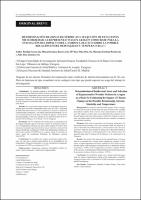Por favor, use este identificador para citar o enlazar este ítem:
https://repositorio.usj.es/handle/123456789/415
| Título : | Determinación de zonas isotérmicas y selección de estaciones meteorológicas representativas en Aragón como base para la estimación del impacto del cambio climático sobre la posible relación entre mortalidad y temperatura |
| Otros títulos : | Determination of isothermal areas and selection of representative weather stations in Aragon as a basis for estimating the impact of climate change on the possible relationship between mortality and temperatura |
| Autor: | Roldán García, Esther



Gómez Barrera, Manuel 


Pino Otín, Rosa 

Pradas, Mariano Esteban 
Jiménez, Julio Díaz 
|
| Palabras clave : | Temperatura ambiente; Cambio climático; Análisis por conglomerados |
| Fecha de publicación: | dic-2011 |
| Editorial : | Ministerio de Sanidad y Consumo |
| Citación : | García ER, Barrera MG, Otín MRP, Pradas ME, Jiménez JD. Determination of isothermal areas and selection of representative weather stations in Aragon as a basis for estimating the impact of climate change on the possible relationship between mortality and temperature. Rev Esp Salud Publica 2011;85(6):603-610. |
| Resumen : | Fundamento: En regiones extensas y diversificadas, como Ara-gón, se cree la necesidad de dividirlas en áreas en función de las varia-bles atmosféricas disponibles, para seleccionar una estación meteoroló-gica representativa. El objeto de este artículo es determinar la existencia de regiones isotérmicas y seleccionar las estaciones representativas con el fin de estudiar la correlación entre variables de temperatura y morta-lidad diaria. Métodos: Se seleccionaron datos diarios de temperatura máxima y mínima para el periodo comprendido entre enero de 1987 y diciembre de 2006. Para determinar las zonas isotérmicas se realizó un análisis de conglomerados jerárquicos y un análisis factorial discriminante, así co-mo un tratamiento previo de datos de relleno de lagunas y detección de heterogeneidades en las series climáticas. Se analizaron datos de 93 es-taciones (44 en Huesca, 15 en Teruel y 34 en Zaragoza). Resultados: De los resultados del análisis para la regionalización de Aragón extrajimos que un solo factor explica la varianza de cada se-rie. En temperaturas máximas ese único factor explicó el 93,43% de la varianza y la estación que representó un mayor factor de correlación fue Huesca-Monflorite (correlación=0,984). Para temperaturas mínimas un único factor explicó el 90,88% de la varianza, siendo la estación con mayor factor de correlación Pallaruelo de Monegros (correla-ción=0,976). Conclusiones: Se consideró que Aragón es una única región isotér-mica con una única estación representativa de la variabilidad de las temperaturas, Zaragoza-Aeropuerto, con una correlación en temperatu-ras máximas de 0,980 y en mínimas de 0,974. |
| Descripción : | Background: In extensive and diversified regions, such as Aragon, it is believed the need to divide them into areas in terms of the available atmospheric variables with a view to select a representative weather sta-tion. The objective of this study was to determine the existence of iso-thermal regions and select representative stations for Aragon in order to carry out further study on the correlation between variables of tempera-ture and daily mortality. Methods: Daily data on maximum and minimum temperature for the period between January 1987 and December 2006 was selected. In order to determine the isothermal areas a cluster analysis and a discrimi-nate factor analysis were carried out along with a data pretreatment of filled gaps and detection of inhomogeneities in the climatic series. We analyzed data from 93 stations (44 in Huesca, 15 in Teruel and 34 in Zaragoza). Results: The results of the analysis for the regionalization of Aragon lead us to conclude that a unique factor explains the variance of each series; at high temperatures one factor explains 93.43% of the variance and the station with the highest correlation factor is Monflorite-Huesca (correlation = 0.984). At low temperatures one factor explains 90.88% of the variance, with Monegros-Pallaruelo being the station that presents the greatest correlation factor (correlation = 0.976). Conclusions: It was felt that Aragon was a unique isothermal region with one unique representative station of the temperature variability, Zaragoza-Airport with a correlation of 0.980 in maximum temperatures and 0.974 minimum. |
| URI : | https://repositorio.usj.es/handle/123456789/415 |
| ISSN : | 1135-5727 |
| Aparece en las colecciones: | Artículos de revistas |
Ficheros en este ítem:
| Fichero | Descripción | Tamaño | Formato | |
|---|---|---|---|---|
| DETERMINACIÓN DE ZONAS ISOTÉRMICAS Y SELECCIÓN DE ESTACIONES....pdf | 629,47 kB | Adobe PDF |  Visualizar/Abrir |
Este ítem está sujeto a una licencia Creative Commons Licencia Creative Commons

